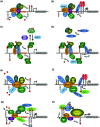Epigenetic regulation of epithelial-mesenchymal transition
- PMID: 27392607
- PMCID: PMC5459373
- DOI: 10.1007/s00018-016-2303-1
Epigenetic regulation of epithelial-mesenchymal transition
Abstract
Epithelial-mesenchymal transition (EMT) is an essential process for morphogenesis and organ development which reversibly enables polarized epithelial cells to lose their epithelial characteristics and to acquire mesenchymal properties. It is now evident that the aberrant activation of EMT is also a critical mechanism to endow epithelial cancer cells with migratory and invasive capabilities associated with metastatic competence. This dedifferentiation program is mediated by a small cohort of pleiotropic transcription factors which orchestrate a complex array of epigenetic mechanisms for the wide-spread changes in gene expression. Here, we review major epigenetic mechanisms with an emphasis on histone modifications and discuss their implications in EMT and tumor progression. We also highlight mechanisms underlying transcription regulation concerted by various chromatin-modifying proteins and EMT-inducing transcription factors at different molecular layers. Owing to the reversible nature of epigenetic modifications, a thorough understanding of their functions in EMT will not only provide new insights into our knowledge of cancer progression and metastasis, but also facilitate the development of diagnostic and therapeutic strategies for human malignancy.
Keywords: Epigenetics; Epithelial–mesenchymal transition; Histone modifications; Transcription regulation; Tumor progression.
Figures

References
Publication types
MeSH terms
Substances
Grants and funding
LinkOut - more resources
Full Text Sources
Other Literature Sources

